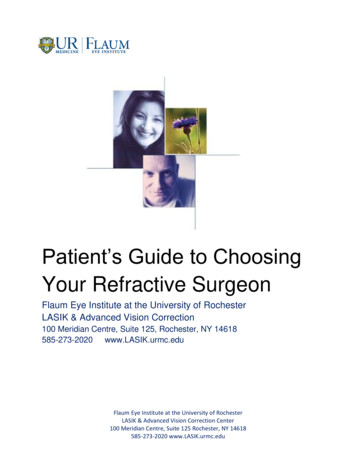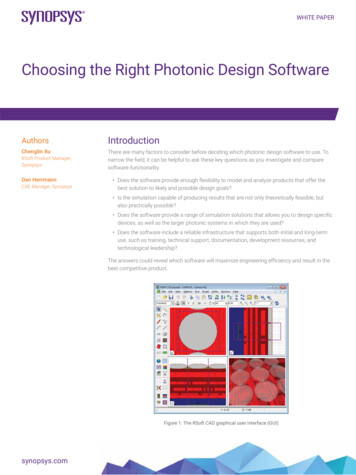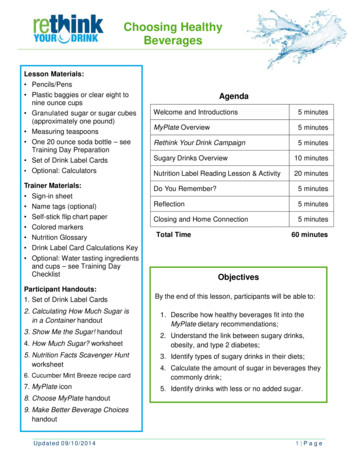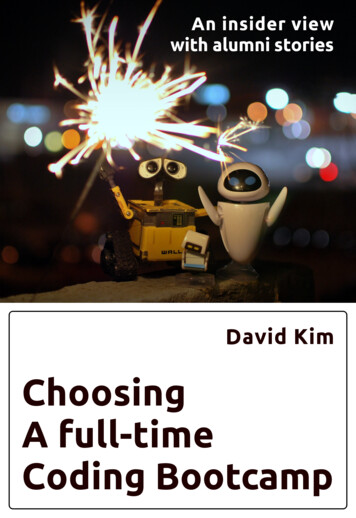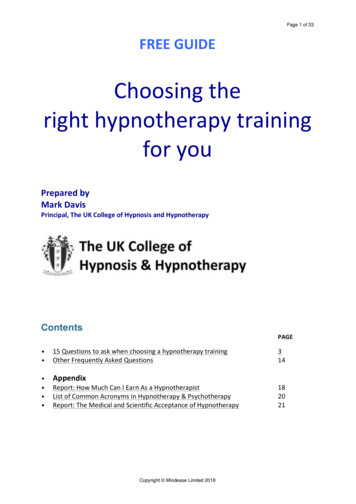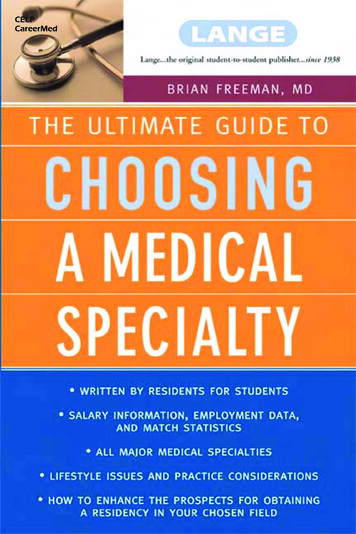
Transcription
CELPCareerMed
CELPCareerMeda LANGE medical bookTHE ULTIMATE GUIDE TOCHOOSINGA MEDICALSPECIALTYBrian Freeman, MDResident in Anesthesiology and Critical CareUniversity of Chicago HospitalsChicago, IllinoisAnd Associate AuthorsLange Medical Books/McGraw-HillMedical Publishing DivisionNew York Chicago San Francisco Lisbon LondonMadrid Mexico City Milan New Delhi San JuanSeoul Singapore Sydney Toronto
CELPCareerMedCopyright 2004 by The McGraw-Hill Companies, Inc. All rights reserved. Manufacturedin the United States of America. Except as permitted under the United States Copyright Actof 1976, no part of this publication may be reproduced or distributed in any form or by anymeans, or stored in a database or retrieval system, without the prior written permission of thepublisher.0-07-145713-5The material in this eBook also appears in the print version of this title: 0-07-141052-X.All trademarks are trademarks of their respective owners. Rather than put a trademark symbolafter every occurrence of a trademarked name, we use names in an editorial fashion only, andto the benefit of the trademark owner, with no intention of infringement of the trademark.Where such designations appear in this book, they have been printed with initial caps.McGraw-Hill eBooks are available at special quantity discounts to use as premiums and salespromotions, or for use in corporate training programs. For more information, please contactGeorge Hoare, Special Sales, at george hoare@mcgraw-hill.com or (212) 904-4069.TERMS OF USEThis is a copyrighted work and The McGraw-Hill Companies, Inc. (“McGraw-Hill”) and itslicensors reserve all rights in and to the work. Use of this work is subject to these terms.Except as permitted under the Copyright Act of 1976 and the right to store and retrieve onecopy of the work, you may not decompile, disassemble, reverse engineer, reproduce, modify,create derivative works based upon, transmit, distribute, disseminate, sell, publish orsublicense the work or any part of it without McGraw-Hill’s prior consent. You may use thework for your own noncommercial and personal use; any other use of the work is strictlyprohibited. Your right to use the work may be terminated if you fail to comply with theseterms.THE WORK IS PROVIDED “AS IS.” McGRAW-HILL AND ITS LICENSORS MAKE NOGUARANTEES OR WARRANTIES AS TO THE ACCURACY, ADEQUACY ORCOMPLETENESS OF OR RESULTS TO BE OBTAINED FROM USING THE WORK,INCLUDING ANY INFORMATION THAT CAN BE ACCESSED THROUGH THEWORK VIA HYPERLINK OR OTHERWISE, AND EXPRESSLY DISCLAIM ANYWARRANTY, EXPRESS OR IMPLIED, INCLUDING BUT NOT LIMITED TO IMPLIEDWARRANTIES OF MERCHANTABILITY OR FITNESS FOR A PARTICULARPURPOSE. McGraw-Hill and its licensors do not warrant or guarantee that the functionscontained in the work will meet your requirements or that its operation will be uninterruptedor error free. Neither McGraw-Hill nor its licensors shall be liable to you or anyone else forany inaccuracy, error or omission, regardless of cause, in the work or for any damagesresulting therefrom. McGraw-Hill has no responsibility for the content of any informationaccessed through the work. Under no circumstances shall McGraw-Hill and/or its licensorsbe liable for any indirect, incidental, special, punitive, consequential or similar damages thatresult from the use of or inability to use the work, even if any of them has been advised of thepossibility of such damages. This limitation of liability shall apply to any claim or causewhatsoever whether such claim or cause arises in contract, tort or otherwise.DOI: 10.1036/0071457135
CELPCareerMedFor RebeccaWithout you, this book would never have been conceived. You are myinspiration—each and every day—for all that I do and all that I hope toachieve. Thank you for your love, for your never-ending support anddevotion, and for always being there with a soft “pet” whenever I needone. I am yours forever.
CELPCareerMedThis page intentionally left blank.
CELPCareerMedFor more information about this title, click hereContentsInternet Resources Guide . . . . . . . . . . . . . . . . . . . . . . . . . . Inside Front CoverAuthors . . . . . . . . . . . . . . . . . . . . . . . . . . . . . . . . . . . . . . . . . . . . . . . . . . . . . . xiPreface . . . . . . . . . . . . . . . . . . . . . . . . . . . . . . . . . . . . . . . . . . . . . . . . . . . . . . xvPart 1. Planning Your Medical Career1. Choosing a Specialty: The Most Difficult Decision of Your Career32. The Specialization of Medicine . . . . . . . . . . . . . . . . . . . . . . . . . .133. Ten Factors to Consider in Specialty Selection . . . . . . . . . . . . . . .234. Personality Assessment: Are You My Type? . . . . . . . . . . . . . . . . . .355. Finding the Perfect Specialty . . . . . . . . . . . . . . . . . . . . . . . . . . . .456. Special Considerations for Women . . . . . . . . . . . . . . . . . . . . . . . .597. Combined Residency Programs . . . . . . . . . . . . . . . . . . . . . . . . . .718. Options for the Undecided Medical Student . . . . . . . . . . . . . . . .819. Applying for Residency: An Overview of the Match Process . . . . .8710. Love and Medicine: The Couples Match . . . . . . . . . . . . . . . . . . .10911. Top Secret! The Ultimate Guide to a Successful Match . . . . . . . .11912. Your Medical Career Beyond Residency . . . . . . . . . . . . . . . . . . . .137Part 2. Specialty Profiles13. Anesthesiology . . . . . . . . . . . . . . . . . . . . . . . . . . . . . . . . . . . . . . . .Brian Freeman, MD15114. Dermatology . . . . . . . . . . . . . . . . . . . . . . . . . . . . . . . . . . . . . . . . .Amy J. Farmer, MD16915. Emergency Medicine . . . . . . . . . . . . . . . . . . . . . . . . . . . . . . . . . .Jeremy Graff, MD181v
CELPCareerMedviCONTENTS16. Family Practice . . . . . . . . . . . . . . . . . . . . . . . . . . . . . . . . . . . . . . .Michael Mendoza, MD, MPH, and Lisa Vargish, MD, MS19917. General Surgery . . . . . . . . . . . . . . . . . . . . . . . . . . . . . . . . . . . . . .Danagra Georgia Ikossi, MD and Jonathan Long Le, MD21318. Internal Medicine . . . . . . . . . . . . . . . . . . . . . . . . . . . . . . . . . . . . .Jennifer Lamb, MD and Ian Tong, MD22919. Neurology . . . . . . . . . . . . . . . . . . . . . . . . . . . . . . . . . . . . . . . . . . .Tomasz Zabiega, MD25120. Neurosurgery . . . . . . . . . . . . . . . . . . . . . . . . . . . . . . . . . . . . . . . .M. Jafer Ali, MD26721. Obstetrics & Gynecology . . . . . . . . . . . . . . . . . . . . . . . . . . . . . . . .Kelly Oberia Elmore, MD, LT, MC, USNR28122. Ophthalmology . . . . . . . . . . . . . . . . . . . . . . . . . . . . . . . . . . . . . . .Andrew Schwartz, MD29523. Orthopedic Surgery . . . . . . . . . . . . . . . . . . . . . . . . . . . . . . . . . . . .John C. Langland, MD30924. Otolaryngology . . . . . . . . . . . . . . . . . . . . . . . . . . . . . . . . . . . . . . .Daniel J. Lee, MD32125. Pathology . . . . . . . . . . . . . . . . . . . . . . . . . . . . . . . . . . . . . . . . . . .Lisa Yerian, MD33326. Pediatrics . . . . . . . . . . . . . . . . . . . . . . . . . . . . . . . . . . . . . . . . . . .Aaron J. Miller, MD34927. Physical Medicine & Rehabilitation . . . . . . . . . . . . . . . . . . . . . . .Vicki Anderson, MD, MBA36728. Plastic Surgery . . . . . . . . . . . . . . . . . . . . . . . . . . . . . . . . . . . . . . .Gregory H. Borschel, MD38329. Psychiatry . . . . . . . . . . . . . . . . . . . . . . . . . . . . . . . . . . . . . . . . . . .Kathleen Ang-Lee, MD39730. Radiation Oncology . . . . . . . . . . . . . . . . . . . . . . . . . . . . . . . . . . .Stephanie E. Weiss, MD413
CELPCareerMedCONTENTSvii31. Radiology . . . . . . . . . . . . . . . . . . . . . . . . . . . . . . . . . . . . . . . . . . .Derek Fimmen, MD42932. Urology . . . . . . . . . . . . . . . . . . . . . . . . . . . . . . . . . . . . . . . . . . . . .Jane Lewis, MD443Index . . . . . . . . . . . . . . . . . . . . . . . . . . . . . . . . . . . . . . . . . . . . . . . . . . . . . .457
CELPCareerMedThis page intentionally left blank.
CELPCareerMedAuthorsM. Jafer Ali, MDResident in Neurosurgery, Department of Neurosurgery, University ofMichigan Hospital, Ann Arbor, Michiganmirali@umich.eduNeurosurgeryVicki Anderson, MD, MBAResident, McGaw Medical Center of Northwestern University, RehabilitationInstitute of Chicago, Chicago, Illinoisvanders2@gsb.uchicago.eduPhysical Medicine & RehabilitationKathleen Ang-Lee, MDResident, Department of Psychiatry, University of Washington Medical Center,Seattle, y H. Borschel, MDThe Ethel C. Coller Research Fellow, Department of Surgery; Plastic SurgeryResident, Section of Plastic Surgery, University of Michigan Medical School,Ann Arbor, Michiganborschel@umich.eduPlastic SurgeryKelly Oberia Elmore, MD, LT, MC, USNRResident, Department of Obstetrics and Gynecology, Naval Medical Center,San Diego, Californiakellyelmore6867@msn.comObstetrics & GynecologyAmy J. Farmer, MDResident, Division of Dermatology, University of Chicago Hospitals, xCopyright 2004 by The McGraw-Hill Companies, Inc. Click here for terms of use.
CELPCareerMedxAUTHORSDerek Fimmen, MDResident, Department of Radiology, University of Chicago Hospitals, n Freeman, MDResident in Anesthesiology and Critical Care, University of Chicago Hospitals,Chicago, Illinoisnerveblock1@yahoo.comChoosing a Specialty: The Most Difficult Decision of Your Career; TheSpecialization of Medicine; Ten Factors to Consider in Specialty Selection;Personality Assessment: Are You My Type?; Finding the Perfect Specialty;Special Considerations for Women; Combined Residency Programs; Optionsfor the Undecided Medical Student; Applying for Residency: An Overview ofthe Match Process; Love and Medicine: The Couples Match; Top Secret!The Ultimate Guide to a Successful Match; Your Medical Career BeyondResidency; AnesthesiologyJeremy Graff, MDResident, Department of Emergency Medicine, Alameda County MedicalCenter, Highland Hospital, Oakland, Californiajgraff@hghed.comEmergency MedicineDanagra Georgia Ikossi, MDResident in General Surgery, Department of Surgery, Stanford UniversityMedical Center, Stanford, Californiaikossile@aol.comGeneral SurgeryJennifer Lamb, MDResident, Department of Internal Medicine, Stanford University Hospitals,Stanford, Californiajrlambmed@hotmail.comInternal MedicineJohn C. Langland, MDOrthopedic Surgeon, Steindler Orthopedic Clinic, Iowa City, IowaOrthopedic Surgery
CELPCareerMedAUTHORSxiJonathan Long Le, MDResident in Plastic Surgery, Department of Plastic Surgery, University ofCalifornia, San Franciscoikossile@aol.comGeneral SurgeryDaniel J. Lee, MDAssistant Professor, University of Massachusetts Medical School; Director, TheSounds of Life Center, UMass Memorial Medical Center, Worcester,Massachusetts; Lecturer, Department of Otology and Laryngology, HarvardMedical School, Boston, Massachusetts; Research Associate, Eaton-PeabodyLaboratory, Massachusetts Eye and Ear Infirmary, Boston, yJane Lewis, MDResident in Urology, Harvard Program in Urology, Harvard Medical School,Boston, Massachusettsjlewis9@partners.orgUrologyMichael Mendoza, MD, MPHResident, Family Practice Residency Program, University of California, SanFrancisco and San Francisco General Hospitalmdmendoz@yahoo.comFamily PracticeAaron J. Miller, MDAttending Pediatrician, Jacobi Medical Center, Bronx, New Yorksafehomes@fastmail.fmPediatricsAndrew Schwartz, MDResident Physician, Mount Sinai School of Medicine, The Mount SinaiHospital, New York, New Yorkandysmd@aol.comOphthalmology
CELPCareerMedxiiAUTHORSIan Tong, MDResident, Department of Internal Medicine, Stanford University Hospitals,Stanford, Californiatongdoc@hotmail.comInternal MedicineLisa Vargish, MD, MSResident, Family Practice Residency Program, University of California, SanFrancisco and San Francisco General Hospitallvargish@yahoo.comFamily PracticeStephanie E. Weiss, MDChief Resident, Department of Radiation Oncology, The Sidney KimmelComprehensive Cancer Center at Johns Hopkins, Baltimore, Marylandweissst@jhmi.eduRadiation OncologyLisa Yerian, MDResident, Department of Pathology, University of Chicago Hospitals, hologyTomasz Zabiega, MDAttending Neurologist, Joliet Pain Center, and Medical Director of PracticeDevelopers of Illinois, Inc., Joliet, Illinoistzabiega@hotmail.comNeurology
CELPCareerMedPrefaceThree years ago I was a confused third-year medical student, not having any ideaabout the next step in my education and professional training. Deciding on a career in medicine was easy; choosing a specialty, on the other hand, was agonizing. Like my classmates, I felt overwhelmed by the number of choices. I imagined myself as a future surgeon or emergency medicine physician, but afterextensive research and clinical experiences, I soon discovered that anesthesiology was the perfect fit. I realized at the time that medical students need a goodwritten resource to guide them through this difficult career-defining decision.This is when the idea for The Ultimate Guide to Choosing a Medical Specialtywas born. Today’s doctor-in-training requires as much information as possible tomake a confident decision, but has little time to gather it. A single comprehensive resource, this book provides detailed insight into each field and allows students to quickly and easily compare specialties under consideration.SPECIAL FEATURES An “insider’s look” into different areas of medicine—specialty chapters written by residents who recently made their career decisionsCandid and revealing descriptions of each specialty, including the pros andthe cons, plus salary information, employment data, match statistics, andmuch moreProfiles of the major medical specialties, including those to which medicalstudents may receive little exposure, such as radiation oncologyA concise up-to-date guide to the residency application and matching process, including a separate chapter dedicated to the “Couples Match”A special chapter with explicit advice to help medical students maximizetheir success in obtaining a residency position in each fieldORGANIZATIONThis book is organized into two major sections. Part 1, “Planning Your MedicalCareer,” delves into the main issues surrounding the choice of one’s medical specialty. These 12 chapters provide everything you need to begin making this major decision—how to research each specialty, what to do if you remain undecided,how to apply for a residency position, and much more. This section is especiallyxiiiCopyright 2004 by The McGraw-Hill Companies, Inc. Click here for terms of use.
CELPCareerMedxivPREFACEvaluable if read early during your medical education. In Part 2, “Specialty Profiles,” a chapter is devoted to each of the 20 major medical disciplines, all following a similar format and exploring common themes. Interspersed throughoutthe text are special inserts—“Vital Signs” and “The Inside Scoop”—that provideeasy-to-read factoids like salary information and match statistics.AUDIENCEMost readers interested in this book are current medical students—allopathic andosteopathic, and those who attend medical school in the U.S. and abroad. Butyou do not have to be a medical student in order to get something out of thisbook. Many residents have second thoughts about their chosen specialty and wishto change fields. In addition, pre-medical college students, as well as anyone considering medicine as a possible career, will find this book helpful.FEEDBACKFor comments and suggestions about the book, you are invited to contact the author by e-mail (nerveblock1@yahoo.com) or by regular mail:Brian Freeman, MDc/o McGraw-HillMedical Publishing Division2 Penn Plaza, 12th floorNew York, NY 10121-2298Your feedback is invaluable for continuing to make this book a must-have resource for future medical students. If you have questions regarding specific areasof medicine, you may e-mail the contributor of that specialty chapter. Their biographical and contact information can be found at the end of each chapter.ACKNOWLEDGMENTSMany people helped make this book a reality. I first would like to acknowledgemy mother, Ellen, for all her guidance, love, and support throughout my life. Ialso owe a huge debt of gratitude to the following people who shared their encouragement and advice: Eric Freeman, Gertrude Eichschlag, Victor Osinaga,Derek Fimmen, and Dr. William McDade, who graciously spent time reviewingmy own specialty chapter. A special “meow” goes out to Foo and Casper, our two
CELPCareerMedPREFACExvCornish Rex cats who kept my lap warm on cold winter nights while writing thisbook.In the medical publishing division of McGraw-Hill, a fantastic team of editors helped bring this book into creation. Shelley Reinhardt, the editor-in-chief,went out of her way to nurture a new author. Susan Meigs offered unparalleledediting expertise and countless useful suggestions that were right on target. Theentire copyediting and production team turned words and thoughts into a readerfriendly and fun package.I especially thank the extraordinary writers who contributed chapters on theirspecialties for this book. Even while under the stress and hardship of being a resident, their passion for their chosen careers shines through in their work. Thisspecial group of physicians includes Jafer Ali, Vicki Anderson, Kathleen Ang-Lee,Gregory Borschel, Kelly Elmore, Amy Farmer, Derek Fimmen, Jeremy Graff,Danagra Ikossi, Jennifer Lamb, John Langland, Jonathan Le, Daniel Lee, JaneLewis, Michael Mendoza, Aaron Miller, Andrew Schwartz, Ian Tong, Lisa Vargish, Stephanie Weiss, Lisa Yerian, and Tomasz Zabiega.Brian Freeman, MDChicago, IllinoisDecember 2003
CELPCareerMedThis page intentionally left blank.
CELPCareerMed1PLANNINGYOURMEDICALCAREERCopyright 2004 by The McGraw-Hill Companies, Inc. Click here for terms of use.
CELPCareerMedThis page intentionally left blank.
CELPCareerMed1CHOOSING ASPECIALTY: THE MOSTDIFFICULT DECISIONOF YOUR CAREER“Is it true that gynecologists have the worst sex lives of all doctors?”“Are you going to be a neurosurgeon like your mother?”“Why don’t you look into dermatology? It’s got easy hours and you’ll make good money.”Throughout their education, medical students never stop hearing these kinds ofcomments. Starting from the moment of acceptance into medical school, these questions continue well into the final year of earning the MD. As they undertake the firstmajor professional decision of their career, medical students often struggle to comeup with a good answer. After all, it seems like just about everyone has a strong opinion on the “best” specialty for a future doctor. That person could be an advisor, parent, supervising physician, or even Aunt Betty at the annual family reunion. From anesthesiology to urology, there are over 60 specialties and subspecialties (Table 1–1).How will a medical student make an educated decision?“MD” REALLY STANDS FOR “MAJOR DECISIONS”Medicine is a profession that requires overwhelming sacrifice and commitment.You have to spend over 200,000 for four years of rigorous education, followedby many long, tough years of on-the-job training. Like life in general, many important decisions line the road to becoming a doctor. Think back to the day when3Copyright 2004 by The McGraw-Hill Companies, Inc. Click here for terms of use.
CELPCareerMed4PART 1 / PLANNING YOUR MEDICAL CAREERTABLE 1–1RECOGNIZED MEMBERS OF THE AMERICAN BOARD OF MEDICAL SPECIALTIES (ABMS)SPECIALTY BOARDYEAROFFOUNDINGAllergy and immunology1971Anesthesiology1941Colon and rectal surgery1949Dermatology1932Emergency medicine1979Family practice1969Internal medicine1936Medical genetics1993Neurological surgery1940Nuclear medicine1971Obstetrics and gynecology1930Ophthalmology1917Orthopedic cs1933Physical medicine and rehabilitation1947Plastic surgery1941Preventive medicine1949Psychiatry and neurology1935Radiology1935Surgery1937Thoracic surgery1970Urology1935Source: American Board of Medical Specialties.you decided on a career in medicine. Whether you were a college student, trying to pick between medicine, engineering, or public policy or perhaps an older,nontraditional applicant who chose to leave a well-paying—but unrewarding—job for a new calling in medicine, it was one of life’s biggest decisions. After slogging through tedious premedical courses and the application process, you thenmade the choice of where to attend medical school.
CELPCareerMedCHAPTER 1 / CHOOSING A SPECIALTY5Now, another career-defining challenge awaits. The medical school experience is more than just memorizing the arteries of the arm, holding retractors during surgery, and learning how to use a stethoscope. Each and every medical student has to go through four years of grueling examinations, sleepless nights oncall, and tough clinical rotations. Despite these hurdles, most medical studentssee eye to eye on what is really the greatest challenge of all—choosing one’s medical specialty. Figuring out what type of doctor to be is, in many ways, more difficult than deciding to become a physician. Once medical students settle on aspecific niche within medicine, they become more than just future doctors. Theystart to take on a new identity—that of a pediatrician, forensic psychiatrist, endocrinologist, orthopedic surgeon, or interventional neuroradiologist.The specialties themselves are quite diverse. Graduating doctors have thefreedom to choose from a wide variety of medical fields. Some are based strictlyon an organ system, like the brain (neurosurgery and neurology), the heart (cardiology), and the male genitourinary system (urology). Others provide comprehensive medical care for specific population groups, such as women (obstetricsand gynecology) and children (pediatrics). Another set of specialties share in common the fact that they are hospital-based services. Its members include radiology,pathology, anesthesiology, and emergency medicine. Medical specialties can alsogenerally be divided into two main groups: primary care (long-term comprehensive care) versus secondary/tertiary care (referral-based care). Generalist specialties like family practice, internal medicine, and pediatrics are considered primarycare fields. More specialized areas such as gastroenterology, dermatology, and cardiothoracic surgery fall into the latter category.Everyone knows that medical school has many rigorous demands: patientcare, lectures, rounds, examinations, and call schedules all compete for a medical student’s time, often crowding out sleep and a personal life. As a result, moststudents have even less time for the proper self-assessment, research, and exploration required to choose the right specialty. Every medical student agrees that itis the most difficult professional decision that they will have to make. Yet mostwill probably spend more time researching what kind of car to buy! In the end,many hastily choose their lifetime careers without having all the information theyneed to make an educated decision.This book is designed to help medical students make an informed choice bythe time senior year rolls around. Deciding on a field of medicine is often described as matching oneself with the characteristics of a particular specialty, suchas lifestyle, intellectual challenge, technological focus, and research potential.Because of these factors, there is much confusion, frustration, and uncertainty
CELPCareerMed6PART 1 / PLANNING YOUR MEDICAL CAREERinvolved in this defining moment of a young physician’s career. Poor decisionmaking can have considerable implications for one’s professional happiness laterin life.INTERNSHIP, RESIDENCY, AND FELLOWSHIPMedical school is only the first step in learning how to become a competent, caring physician. There are three different types of on-the-job training that commence immediately following graduation from medical school. These avenuestake young, inexperienced doctors and turn them into well-trained specialists,ready to cure disease and save lives. Choosing a specialty determines what formof further professional training is required after medical school. Today’s medicalstudent, therefore, needs a clear understanding of the structure of postgraduatemedical education.Medical students have to commit to their specialty to begin the next phasein training: residency. During the past 60 years, rapid advancements in medicalscience created a greater demand for specialists, which residency programs expanded to meet. Depending on the specialty, residency consists of 3 to 7 years ofadditional formal training and study (under physician supervision). Medicalschool only provides a broad clinical foundation. Residency takes it one step further and confers the skills, knowledge, and experience necessary to practice medicine unsupervised in a given specialty. Being a resident physician is kind of likeworking as an indentured servant. You work long hours for little pay and spendmany nights sleeping in the hospital. In fact, residency earned its name from theold days when house staff physicians actually lived on hospital grounds, as residents.Through the National Resident Matching Program, graduating medical students may enter residency training in 20 different specialties. You actually haveeven more options. Here is why. The American Board of Medical Specialties(ABMS) recognizes 24 official specialty boards. But every year, statistical datafrom the residency match show that nearly all medical students enter 1 of only20 areas. What about the remaining four? Three of the specialties—medical genetics, preventive medicine, and nuclear medicine—offer such a small handfulof residency positions (16 total in 2002) that few students really consider them asoptions. The other disciplines—allergy medicine and thoracic and colorectal surgery—are really considered subspecialties of internal medicine and surgery, respectively. (Psychiatry and neurology both share the same specialty board, andradiation oncology falls under the jurisdiction of radiology). In addition, students
CELPCareerMedCHAPTER 1 / CHOOSING A SPECIALTY7may also select more than one specialty through the combined residency programs described in Chapter 7. Doing the math, these 14 available options bringthe grand total to 34 choices.After deciding on a specialty for residency, many physicians later choose tosubspecialize further by obtaining a fellowship, which can last any number ofyears. Subspecialties exist for nearly every specialty. Examples include rheumatology or infectious disease (internal medicine), vascular surgery (general surgery), pain management (anesthesiology), and retinal surgery (ophthalmology).Because of all the subspecialties, there are over 60 different kinds of doctors outthere! You can be an adolescent medicine specialist, critical care physician, orinterventional radiologist. The choices seem endless. Because areas of subspecialization are primarily of interest to current residents-in-training, they will notbe a major focus of this book. It is important to remember, however, that thesefields are all potential career paths. Do not exclude them from your mind whileyou are contemplating and exploring the 20 basic specialties. Having so manyadditional options just means the decision gets even tougher.Where does internship fit into all this? In the old days (prior to 1970), allgraduating medical students completed a 1-year rotating internship before entering residency. This busy year consisted of all the core specialties: internal medicine, surgery, pediatrics, obstetrics and gynecology, and psychiatry. The goal wasto provide broad hands-on training that would enable a new physician to work inthe community as a general practitioner. After the demise of the formal internship in 1970, only the lingo lives on today. Internship is now simply consideredthe first postgraduate year (PGY-1) of residency. In most hospitals, newly mintedMDs, fresh out of medical school, are usually known as first-year residents ratherthan interns. The old internship does still exist in a disguised form: the transitional year residency. This track (along with other 1-year programs) is discussedfurther in Chapter 9.WHY HAS CHOOSING A SPECIALTY BECOME SO DIFFICULT?Medical Students Are Faced With More Choices ThanEverBack in the old days of medicine, the career options for a graduating medical student were pretty simple: become a general practitioner, or . . . become a generalpractitioner. Medicine has changed quite a bit since that era. New discoveries inscience, advancements in medical care, and high-tech innovations paved the way
CELPCareerMed8PART 1 / PLANNING YOUR MEDICAL CAREERfor the growth of more specialties. Radiology, for instance, prospered greatly fromthe introduction of CT and MRI scans. The discovery of inhalation anestheticsgave birth to anesthesiology, progress in drug therapy revolutionized psychiatry,and the development of the colonoscope created gastroenterology. The list goeson and on. Today, with nearly 60 specialties and subspecialties of medicine, narrowing the choices down to one is more challenging than ever.Clinical Clerkships Have Many LimitationsAfter making it through 2 hard years of basic sciences, medical students have tocomplete a series of clinical clerkships (rotations). The purpose of this hospitalexperience is twofold: (1) to acquire a basic fund of clinical knowledge in thatspecialty, and (2) to explore whether or not that field of medicine may be oneyou want to pursue. For the latter goal, clerkships prove inadequate for many reasons. Most rotations only last from 2 to 8 weeks. During this short period of time,medical students get limited exposure to that specialty. It f
Brian Freeman, MD Resident in Anesthesiology and Critical Care University of Chicago Hospitals Chicago, Illinois And Associate Authors Lange Medical Books/McGraw-Hill Medical Publishing Division New York Chicago San Francisco Lisbon London Madrid Mexico Cit

